Flight information display systems (FIDS) are a passenger’s lifeline. With all the crucial information travelers need to get to their gates on time, they’re bound to create an impression on visitors. The real question is whether that impression is positive or negative.
Flight information display systems (FIDS) are a passenger’s lifeline. With all the crucial information travelers need to get to their gates on time, they’re bound to create an impression on visitors. The real question is whether that impression is positive or negative.
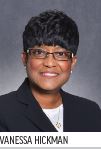 As Nashville International Airport (BNA) kicked off a dynamic growth and expansion plan known as BNA Vision, updating the FIDS and public address system dovetailed nicely with the nearly $1.4 billion initiative.
As Nashville International Airport (BNA) kicked off a dynamic growth and expansion plan known as BNA Vision, updating the FIDS and public address system dovetailed nicely with the nearly $1.4 billion initiative.
“Travel can be very stressful. The more we can do to give customers readily available information at their fingertips, the better,” says Vanessa Hickman, assistant vice president of Information Technology at BNA. “We want our passengers to see very quickly their departures or arrivals. If we can alleviate stress, they can spend more time relaxing and engaging in more revenue-generating activities like food and retail.”
|
facts&figures Project: Upgrading Audio/Visual Communications Primary Components: New Public Address System; Flight Information Display System; Electronic Video Display System Location: Nashville Int’l Airport Cost: $5.9 million Design: Late 2016 – Jan. 2018 Construction/Installation: Spring 2018 System Activated: Aug. 2019 Prime Consultant/Engineering Design: Arora Engineers Design: Gresham Smith Design Support: Connico Prime Contractor/System Integrator: International Display Systems Public Address System Software: Simpleway Public Address System Hardware: QSC FIDS Software & Flight Data: Infax Content Management Software: Omnivex Content Management Software/FIDS Integration: Infax |
During a recent $5.9 million project, crews replaced the entire FIDS, public address (PA) and electronic video display system (EVIDS) at the airport. The new EVIDS allows the airport to run video or important static content, such as emergency messaging, on any display. Previously, the displays included only flight information and weather maps.
“Now, the airport can build on top of this foundation to add all sorts of content, like video, dynamic directories, visual paging and a framework for how they present information to their customers,” says Jason Shevrin, senior vice president with Arora Engineers.
Finer Points for FIDS
Arora tag-teamed with Gresham Smith, which was responsible for creating templates for all of the airport’s digital signage. When Gresham Smith designed BNA’s original terminal in 1986, it was the firm’s first complete terminal project. In this case, the company was tasked with devising color combinations and symbols that would appeal to customers and help ease their journey through the airport. The results showed the BNA team that their FIDS could look and feel better.
“This project was fun because the airport team was very open,” says Jim Harding, Gresham Smith’s director of Experiential Design and Wayfinding. “We got a feel for what they were looking for: clean, crisp and friendly. With that in mind, we leaned toward lighter, brighter imagery that pops.”
 Harding explains that designers emphasized what is most important to passengers: the gate numbers. The new design they created incorporates a blue box to highlight and unify the row and gate numbers to draw the eye toward the gate numbers. The color scheme for the previous FIDS was dark green and blue, which felt heavy, he comments. Brighter screens gave the digital displays a fresh, clean look; and designers employed horizontal banding from white to light blue for clarity. Travelers can quickly find their cities and easily scan across for flight status, says Harding.
Harding explains that designers emphasized what is most important to passengers: the gate numbers. The new design they created incorporates a blue box to highlight and unify the row and gate numbers to draw the eye toward the gate numbers. The color scheme for the previous FIDS was dark green and blue, which felt heavy, he comments. Brighter screens gave the digital displays a fresh, clean look; and designers employed horizontal banding from white to light blue for clarity. Travelers can quickly find their cities and easily scan across for flight status, says Harding.
The new template was also designed to accommodate passengers who are colorblind.
“A couple of years ago, we led a research project and report on enhancing wayfinding for those with visual challenges,” explains Harding. “We used digital filters on our design concepts to represent red/green and blue/green colorblindness, and that showed us if we were using the right level of contrast. A lot of folks might not think of that, but it gave the airport a lot of confidence the FIDS would be legible for all customers.”
Gresham Smith also created a uniform look and feel for everything with information for passengers: signage, directional cues, FIDS, baggage information display systems and more. Harding emphasizes that consistency is important for passengers.
 “You’d be surprised how many people don’t know where to look when they deplane,” agrees Shevrin. “The fonts, colors and logos were standardized to help ensure the way is clear. It’s those small details that make a difference.”
“You’d be surprised how many people don’t know where to look when they deplane,” agrees Shevrin. “The fonts, colors and logos were standardized to help ensure the way is clear. It’s those small details that make a difference.”
Because time is an essential currency for passengers, the local Nashville time is prominently featured on headers. Customer feedback prompted the project team to add “CST” behind the numbers. When crossing multiple zones, it’s easy to lose track, notes Harding. Adding to that challenge, part of Tennessee is in the Eastern time zone, and part is in the Central zone.
The FIDS can also run information about live music presented at various stages throughout BNA. “People think of Nashville as Music City, USA,” says Harding. Each FIDS bank consequently has three screens for flight information and one for alternate content, including what musicians are playing where and when.

Because FIDS are such a crucial touch point for passengers, Harding encourages airports to create unique local content. “It’s the extension of the airport’s voice and brand, and that is really important,” he explains. “If you don’t think of it that way, it’s a missed opportunity.”
Synchronized Sights & Sounds
Instead of building separate FIDS and PA systems, Arora proposed a universal communications system, with a single interface to deliver synchronized visual and audio announcements. The result is consistency between what passengers hear and see.
The challenge was incorporating the concept into the massive construction that was about to kick off.
“We had a paging system that was more than 15 years old,” says Hickman. “The technology behind that was difficult to support, and we needed to replace it. It was a balancing act: We had this project on deck, and the BNA Vision project came up alongside it.”
Disseminating safety and security information was important to airport management, so the new paging system was rolled into plans going forward.
“Sometimes you have bad storms or incidents, and if we need to, we can now take over all of the screens in one isolated area or the whole terminal to tell people where they need to go,” explains Hickman. “It keeps our public safe and secure, and it’s easy breezy.”
International Display Systems, the prime contractor and systems integrator for the project, brought in vendors including Simpleway, Omnivex, Pro Sound and Jarvis Sign. Infax provided messaging for the airport and presented flight information on displays. Infax provided FIDS software and the flight data and integrated the Omnivex content management, which is also integrated with Simpleway’s public address software.
 Because it was already furnishing the security checkpoint wait-time monitors, the company integrated that information as well.
Because it was already furnishing the security checkpoint wait-time monitors, the company integrated that information as well.
“Our unified solutions integrated smoothly into the airport’s public address system for consistent audio and visual messaging airport wide,” says Infax Vice President Tracy Davis. “The software and integration services ensured that BNA’s audio-visual passenger experience was seamless and state-of-the-art.”
In addition to flight information, the airport also displays details about local weather and in-terminal music performances:

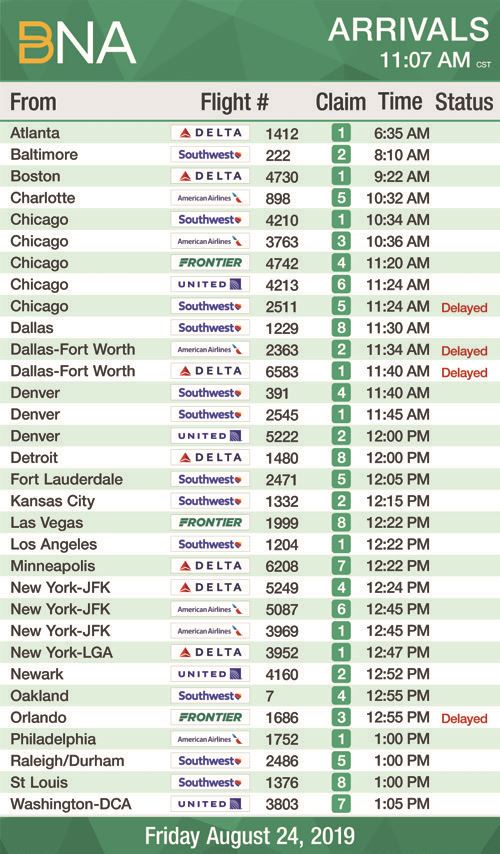
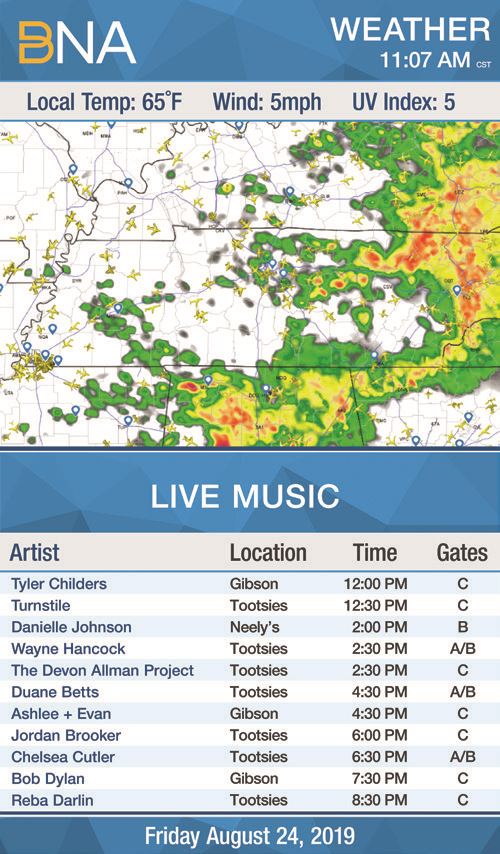

Simplifying the Process
Imagine an old-fashioned marquee that uses large plastic letters to spell out messages—and only one employee has access to the basket of letters. In contrast, digital displays make it easy and fast for a wide variety of employees to update content.
“It was important to us because we want to make sure we’re providing the best service for our traveling public,” says Hickman. “The system we had in place was functional, but we wanted to give our end users the chance to not have to rely so much on IT.”
Previously, personnel had to record an announcement, and then hand it off to more technical staff members in the IT department who could access the paging system. With the new system, any trained and authorized employee can enter an announcement on the network and automatically direct where it needs to go.
“It’s all in their hands now,” says Hickman. “They can integrate from different sources and push content into different components. Before, it took a programmer to do all that. What might have taken a day before now takes less than 15 minutes.”
A graphic artist develops content, and the team juggles emerging content from their suppliers, like concessionaires and various departments within the airport. The new plug-and-play method is more nimble, and allows for faster updates.
“Now, they don’t have to go to three and four different places to change something on the system,” says Shevrin. “They’re empowered and encouraged to change all of those things themselves.”
Music City System
The airport was intent on having a PA system that would not only provide standard announcements, but also convey the local culture.
 In addition to playing celebrity recordings from local musicians like Kellie Pickler, George Strait and the Band Perry, the new Simpleway platform has a custom voice library recorded by a Nashville native for more routine announcements. The project team wanted to ensure that up-to-date flight information and important airport announcements were delivered in a clear and consistent manner.
In addition to playing celebrity recordings from local musicians like Kellie Pickler, George Strait and the Band Perry, the new Simpleway platform has a custom voice library recorded by a Nashville native for more routine announcements. The project team wanted to ensure that up-to-date flight information and important airport announcements were delivered in a clear and consistent manner.
“The audio announcements are shared through a data interface for visible display so every passenger can receive the same information,” adds Brandy Bailey, North America director for Simpleway. “The visual display integration also aids in emergency situations, so that all passengers understand the steps necessary to get to a safe location.”
Making it Work
International Display Systems, the prime contractor/systems integrator for the overall project, leveraged its previous FIDS experience at BNA to make the more recent upgrades. In addition to upgrading and integrating the EVIDS, content management system and public address system, it also layered in the new Omnivex system.
“The existing PA system was past its rated lifecycle and in need of replacement. Further, the airport authority had a vision to fully integrate the EVIDS, content management system and public address system for ADA compliance and customer service excellence,” explains Rob Keelor, vice president of International Display Systems.
“The primary challenge was to migrate the legacy FIDS and public address systems to the new EVIDS, content management system and public address system in a fully-operational airport without any disruptions. This transfer was accomplished by mirroring the databases of the old FIDS and new EVIDS/CMS to allow them to operate in parallel, supporting both the legacy and new systems simultaneously and without interruption.”
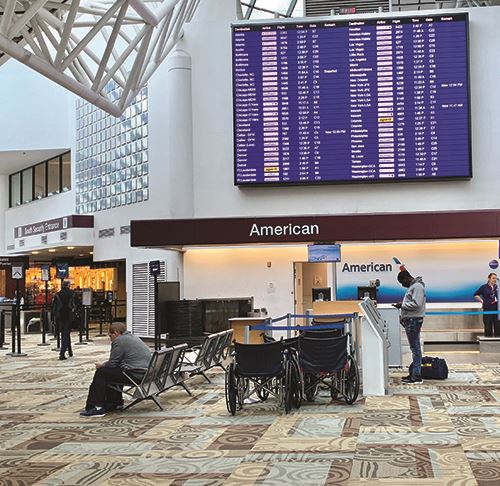
When new links were confirmed, the project team switched over the input sources and interfaces in one shift and decommissioned the old FIDS servers. The public address system was a little more challenging because the new system is network-based, while the old system had a proprietary serial interface. Technicians consequently put the new PA system rack equipment and network microphone stations in the new EVIDS/ content management system/public address system backbone while new speakers and cables were being installed, and then tied the new speakers and speaker cables to existing PA system.
“Once all equipment was installed and operational, we transitioned the PA system around-the-clock over the course of one work week,” Keelor explains. “This allowed us to essentially transition one concourse per night. The next morning, we were ready to train the users on the new system. We supported both old and new systems so there was no loss of operation.”
Dueling Projects
Last year, 18.2 million passengers traveled into and out of BNA—14.2% more than in 2018. And BNA expects passenger traffic to increase from 18 million to 23 million as the city continues to grow.
With nearly $1.4 billion of capital projects, BNA Vision is the airport’s game plan to keep pace with the growth. Major components of the program include:
- a redesigned main lobby;
- on-site hotel;
- additional parking garage with pedestrian plaza;
- more than 90 retail, concessions and passenger services locations;
- 10 additional security screening lanes;
- and a new International Arrivals Facility.
The massive expansion and improvement initiative is slated to wrap up by the end of 2023.
“We had already started the [flight information and public address systems] project, and the rest of the organization was working on the BNA Vision project,” says Hickman. “We had to make sure construction stayed ahead of us. When we started this project, there was a plan to build a new data closet to support what we were doing, and then we had to move it. I didn’t want to get in the way of the BNA Vision project, so we had to stay ahead of it. And because we laid the footprint, we were able to adapt.”
The information/communication systems project had to adjust several times because of other construction schedules; other times it took priority. The successful outcome of this project was based on the cooperation between airport staff and third-party vendors, says Arora’s Shevrin.
“Everyone worked together to ensure staff flexibility so that each piece was installed and ready according to the changing construction schedule,” he says.
Due to other simultaneous construction, the project was installed in phases, and an expansion is planned for the new areas still being built. The new virtual servers were installed first, followed by workstations as the new system became available.
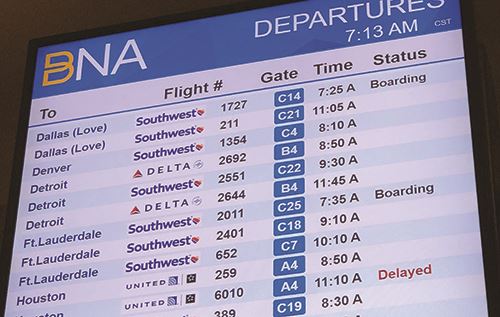
Choose Wisely
Speaking from the airport’s perspective, Hickman stresses the importance of having strong, reliable contractors and vendors for such projects.
“I’d advise you to pick your partner wisely and do your research. And stay in touch with the business side,” she adds. “I’m from IT and like the cool technology; so I have to make sure that it also fits the business.”
On that note, Shevrin says that the lifecycle will be long for the airport’s new FIDS, EVIDS and PA system—at least a decade or more. “Any new audio or visual systems brought on as part of the Vision program will be built onto the system,” he says. “We set the standard for many years to come.”



